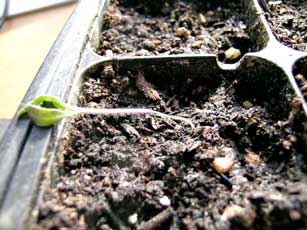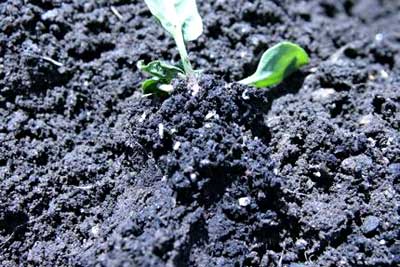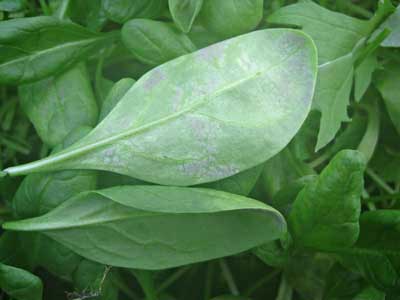As longtime readers will have already noticed, this is the first Pest Report to come from myself and not Eric Sideman. Though Eric has handed over the reins to the Pest Report, we are glad to have him continuing his work for MOFGA part time!
Though it goes without saying for us here in Maine, this is a late spring year. It can still be interesting to look at the USA National Phenology Network maps to see where in the country leaf-out and spring bloom arrived early, where they have arrived late, and we can ground-truth their temperature models and confirm that neither leaf out nor spring bloom have occurred here yet!
– Caleb Goossen, Organic Crop and Conservation Specialist
In this issue:
Seedling Problems
Damping-Off in the Field
Seedcorn (and Other) Maggots
Spinach Downy Mildew
At this time of the year, most plants are still in greenhouses – a much more controlled setting than gardens and fields. As such, a lot of the problems that pop up are abiotic (i.e., not infectious). Sometimes abiotic issues are transient (e.g., cold temperatures) so it’s good to both check new growth to see how it looks relative to any damaged or unusual symptoms elsewhere on the same plant and to check on the health of roots and crown of the plant.
Seedling problems can occur in compost based potting mixes because of the possibility that the compost may be carrying plant pathogens, and it is much more difficult to predict the availability of nutrients from natural sources. Nutrient availability depends on biological activity – which is greatly affected by temperature, moisture and other factors. Many commercially available organic mixes are quite good and consistently free of pathogens, and good with nutrients, but occasionally even these fail.
Damping-off
Damping-off is a disease most commonly seen in young seedling but may (rarely) effect older seedlings. It is caused by species of fungi that commonly live in the upper layers of soil and jump at the opportunity to infect germinating seeds and seedlings, when conditions allow it to. The most common species that cause damping-off are in the genera Pythium and Rhizoctonia.
There are two types of damping-off. The first is one growers often misinterpret because it is pre-emergence damping-off, which rots the sprouting seed before it breaks through the soil. This can be confused for poor seed germination. The fungus attacks any part of the germinating seed especially the tiny growing tips. Post-emergence damping-off begins as a lesion on the root which extends up to the stem and/or above the soil line. The young stem is constricted by the attack and becomes soft, and the plant falls over and dies.
 |
| Seedling affected by damping-off disease. |
Damping-off cannot be cured, but it can be prevented by starting seeds in better conditions (or a “sterile” media). First make sure you are using seeds of the highest quality that will germinate and start growing quickly. Old, mistreated, and weak seeds are more susceptible to damping-off. Anything that slows germination increases the risk of infection. Excessive watering, poor drainage, and “less than optimum” temperatures should be avoided. Allowing the surface of the soil mix to dry a bit before each watering helps. If using seedling trays, adding perlite to your potting mix can help to facilitate soil drying and aeration.
It is possible to “sterilize” your media by baking the mix in the oven at 350 °F for about 45 minutes. The mix should reach 160 °F and should stay at that temperature for 30 minutes. Do not allow it to go higher or stay hot longer because overheating kills the beneficial microorganisms and may releases toxic materials. Many growers prefer not to “sterilize” their mixes because organic mixes are living systems and often the interactions of organisms in the mix reduces the impact of the fungi causing damping-off. In other words, if the damping-off pathogens get into a “sterile” mix, they are off and running free of antagonists and competitors (friendly or neutral microbes present in many biologically active composts). Adding a biological treatment to your potting mix, like Rootshield, may help.
Cold Soil/Wet Soil
In addition to encouraging damping-off, cold soil can cause other problems. For example, growing seedlings on window sills is often a problem because of cold night time temperatures. The roots of plants do not function when cold, and plants frequently display symptoms of malnutrition even though the media may have plenty of nutrients. Purple undersides of leaves, stunted growth, pale weak seedlings, etc., are often the results of cold or wet “feet”.
Wet potting mix, or potting mix that doesn’t get a chance to dry out on the surface can also foster algae growth. While algae is harmless to plants, it can form crusts on seedling cells that make even watering more difficult, or possibly slow air diffusion in and out of the potting media, which can hinder root growth and further exacerbate wet potting mix problems. Algae may also foster fungus gnats, which feed on algae and fungus in damp potting media, and then sometimes on your tender seedlings’ roots. The first step in responding to fungus gnats is cultural – reduce the amount of time your cells have surface moisture. In severe infestations, there is an OMRI approved Bt product, and predatory nematodes that can be effective in killing larval and pupal stages of the gnats.
Trying to grow a tiny seedling in a large container may worsen the problem of wet potting mix because the plant is just not big enough to use the water, and over watering may then be a problem the plant cannot grow out of. Perlite can help to improve drainage in a poorly-draining potting mix.
Salt
Some composts are high in soluble salts. Even if the salts are nutrient salts such as nitrates, high salts will cause water absorption problems and may prevent seeds from germinating. Salty composts are not a problem in field use because they become diluted with the soil, but in a potting mix it is a real problem. Compost used for potting mix should be the best you can get and should not have salts -measured as conductivity on a compost analysis – higher than 1 mmhos.
Carbon:Nitrogen ratio
The C:N ratio is critical for compost used in potting mixes. A high C:N ratio will result in nitrogen lock up, wherein all the nitrogen in the potting mix, and any you add with fertilizers, is being grabbed by the bacteria feeding on the carbon-rich material. It is a sign that the compost was made from an improper mix of feedstock, or perhaps is just not finished yet. Compost used to make potting mixes should have a C:N ratio of 15:1 to 18:1.
Ammonia
As nitrogen is released from decomposing proteins it passes through a phase where it is an ammonium ion. Unfinished compost will have ammonium ions that may revert to ammonia gas which can kill roots and damage leaves. Ammonia in a compost used for a potting soil should be less than 0.1%. Problems from high ammonia levels can be seen as very weak, dying seedlings which have roots that are brown instead of a nice healthy white. Its recommendable to get an analysis of any compost you plan to use to build your own seedling mix. The University of Maine Soil Testing Laboratory does compost testing, just be sure that when you send a sample you ask for the compost analysis. If you are buying a commercial compost-based mix you may want to speak to other growers and see how that brand has worked for them.
DAMPING-OFF IN THE FIELD
Damping-off can occur in the field too. This time of year the problem is with peas and spinach. The disease is usually caused by several different species of Pythium, which is a common soil inhabitant that persists in soil and in root debris as spores. The species have a wide host range of crops and weeds so crop rotation will, unfortunately, do little to avoid the problem.
During, or just after germination are when seedlings begin to show symptoms. The symptoms may be as simple as yellowing and stunting – because sometimes only the root tips are infected and this root “pruning” interrupts growth. Sometimes a soft rot of the stem kills the plant. Sometimes you just don’t see any seedlings emerge at all.
High soil moisture and warm soil temperatures (warmer than optimum for pea growth, i.e., 65-75) favors Pythium. You can’t control the weather but you can choose when you plant your peas. If the soil is very wet, and warm weather is forecast, it may make sense to delay planting a few days for the soil to dry a bit.
There are resistant varieties. In peas, the resistance gene is tied to some visual characteristics of the seed. Wrinkled seeds are more severely affected than smooth, round seeds. Also, some biological seed treatments, such as Rootshield, may help.
 |
| Seedcorn maggot on a spinach seedling. |
SEEDCORN (Hylemya platura) and OTHER MAGGOTS
Now is the time to be aware of the problem. Seedcorn maggot larvae feed on seeds and young seedlings of many crops (corn, beans, beets, peas, spinach, onions, brassicas, etc.). The first symptoms are usually poor germination (or failure of seedlings to emerge), or wilting transplants that have lost their roots to feeding. Symptoms can be difficult to distinguish from other problems, such as damping-off due to Pythium or other soilborne fungi, or wireworm feeding. At least until you dig around a bit and find the maggots.
There are two other common maggot problems here in the Northeast, which are specific to certain crops. These are the onion maggot, and the cabbage maggot (which is a big problem in cabbage, broccoli, cauliflower, radish, and other brassica family members). All of these maggots are problems early in the season, and even though they are still around they become less of a problem by late May/early June because there is much lower egg survival in warm soil.
The species of maggots are very hard to tell apart. It would be good to know which you have because the onion and cabbage maggots will become more of a problem year after year if crop rotation is not followed. And, especially with the cabbage maggot, using the wrong cover crop in a field could be a problem (e.g., you would not want to use tillage radish as a fall cover crop in a field you plan to plant to cabbage the following spring).
In contrast to the cabbage and onion maggots, the seed corn maggot is not specifically attracted to a particular crop but rather is attracted to the smell of decaying organic matter. Seed corn maggots have even been shown to be attracted to decaying soybean meal that was applied as a fertilizer at seeding or transplanting. The maggots can usually be found in the soil around and inside seedlings and seeds.
The adults look like small houseflies. The season’s last generation of adults lay eggs that hatch into maggots, which feed for a while and then pupate late in the fall. They overwinter in the soil as pupae. In early spring, the adults emerge, fly around, and lay eggs either at the base of their favorite plants, or in the case of the seed corn maggot, where they smell organic matter, such as compost or manure added to a field, decaying seeds (or as mentioned above, maybe even soybean meal added as a fertilizer), etc. The eggs hatch within 2-4 days at soil temperatures of 50F. Research has shown that peak emergence of the first three generations of seed corn maggot occur when 200, 600 and 1000 degree days have accumulated. For predicting the peak emergence of these flies, degree days are calculated on a daily basis by using the formula: (Max temp – Min temp)/2 – 39F. To see the degree day data in your area, and lots of other cool data, find your nearest weather station (often at an airport) at https://newa.cornell.edu/.
The first generation of seedcorn maggot usually causes the most damage. The adults prefer to lay eggs in wet soil. Crop seeds that germinate slowly are more vulnerable to attack. Crops that are planted in wet, and or cool soil, may be especially susceptible to damage because of slow growth.
Management strategies:
By the time you see damage, it is too late to control the problem using either cultural or chemical methods. Prevention is the key.
- Avoid seeding fields (especially wet fields) too early. Seeds germinate more quickly and are less vulnerable in warmer and drier soils.
- Disk and incorporate organic matter (such as a cover crop) at least 4 weeks before seeding to give it time to break down and make it less attractive to the flies.
- Avoid applying manure or unfinished compost in late fall or early spring to heavy soils that you might want to plant early. Lighter, well-drained, sandy soils are less likely to have problems (because they warm up and dry out faster than others).
- Rowcovers can help – but only if the maggot flies are coming from elsewhere. Remember, the flies overwinter in the soil as pupae. If you grew a susceptible cover crop, or applied manure in the fall, pupae may be there overwintering, and then flies could end up underneath your rowcover.
- If you need to replant, wait at least 5 days if maggots that you find are a quarter inch long; if they are smaller than that, wait at least 10 days to make sure they have pupated and will not damage the new seeds.
 |
| Downy mildew on spinach |
SPINACH DOWNY MILDEW
Downy mildews are a disease primarily of foliage, causing harm by reducing the photosynthetic capacity of a plant, and making a greens crop unmarketable (and just plain unappetizing for the homestead grower). Spinach downy mildew (Peronospora farinose f.sp. spinaciae), only affects spinach and is noticed first as yellowing patches on leaves, often bounded by leaf veins to create an angular leaf spot. As the disease continues to grow in the plant, it emerges through the stomata on the underside of leaves, producing characteristic fuzzy masses of purplish-gray sporangia. These sporangia are produced overnight and therefore are most easily seen in the morning before they can disperse on air currents.
Until relatively recently spinach downy mildew was a concern primarily in the American West and not in the Northeast. Before 2014 it hadn’t been reported in the Northeast for about 15 years. The disease likely appeared in our region from infected seed, or possibly infected plants that had been shipped in. It spreads predominantly via asexual airborne sporangia, which require a living spinach host (i.e., they don’t persist in soil). Because of this, year-round growing may create a bridge allowing spring greenhouse crops to infect the next season’s outdoor plantings. If two downy mildew mating types (analogous to sexes) are present on the same plant, sexual oospores can be produced as overwintering structures that can persist in the soil for up to three years. These could enable the disease to spread by seed, although researchers still don’t know if this is actually occurring.
Spinach downy mildew was first described in the United States in 1890. Only three identified races of the disease occurred before 1990, but many new races have emerged since then, overcoming the genetic resistance of some spinach varieties. Now 17 races exist, as do one or more currently unlabeled “novel” races. In recent outbreaks in New England, races 12, 14, 15 and a novel race were identified.
Management
The best management approach is to avoid the disease and to limit its spread if it is found. All diseases need both a susceptible host and ideal environmental conditions to both infect and spread. As the name implies, spinach downy mildew infects only spinach; however, researchers haven’t definitively disproven that it could also infect closely related Chenopodium species such as lamb’s quarters.
Many modern spinach varieties have resistance to at least some downy mildew races bred into them, and seed suppliers typically display that resistance information. Although new races of downy mildew will likely continue to emerge, choosing a few varieties that resist one or more races known to have been present in the Northeast the past few years is advisable (i.e., races 12, 14, and 15). Spinach downy mildew favors cool (59 to 70 °F) and humid conditions, which are common in protected growing in late fall and early spring. As a result, best practices include drip instead of overhead irrigation to reduce leaf wetness, generous plant spacing to promote good airflow, horizontal air flow fans angled toward the growing zone, and ventilating and removing row covers when weather conditions allow.
If you have spinach downy mildew confirmed, you may consider pre-emptively harvesting unaffected crop plants before infection sets in, then destroying crop and crop residues, and possibly rotating that soil out of spinach for at least three years. Be sure to destroy any infected greenhouse/high tunnel crops before you or your neighbors are likely to be planting in the field.
For more information and photographs from Dr. Meg McGrath, Cornell plant pathologist, see: Vegetable MD online @ cornell.edu – Spinach Downy Mildew
